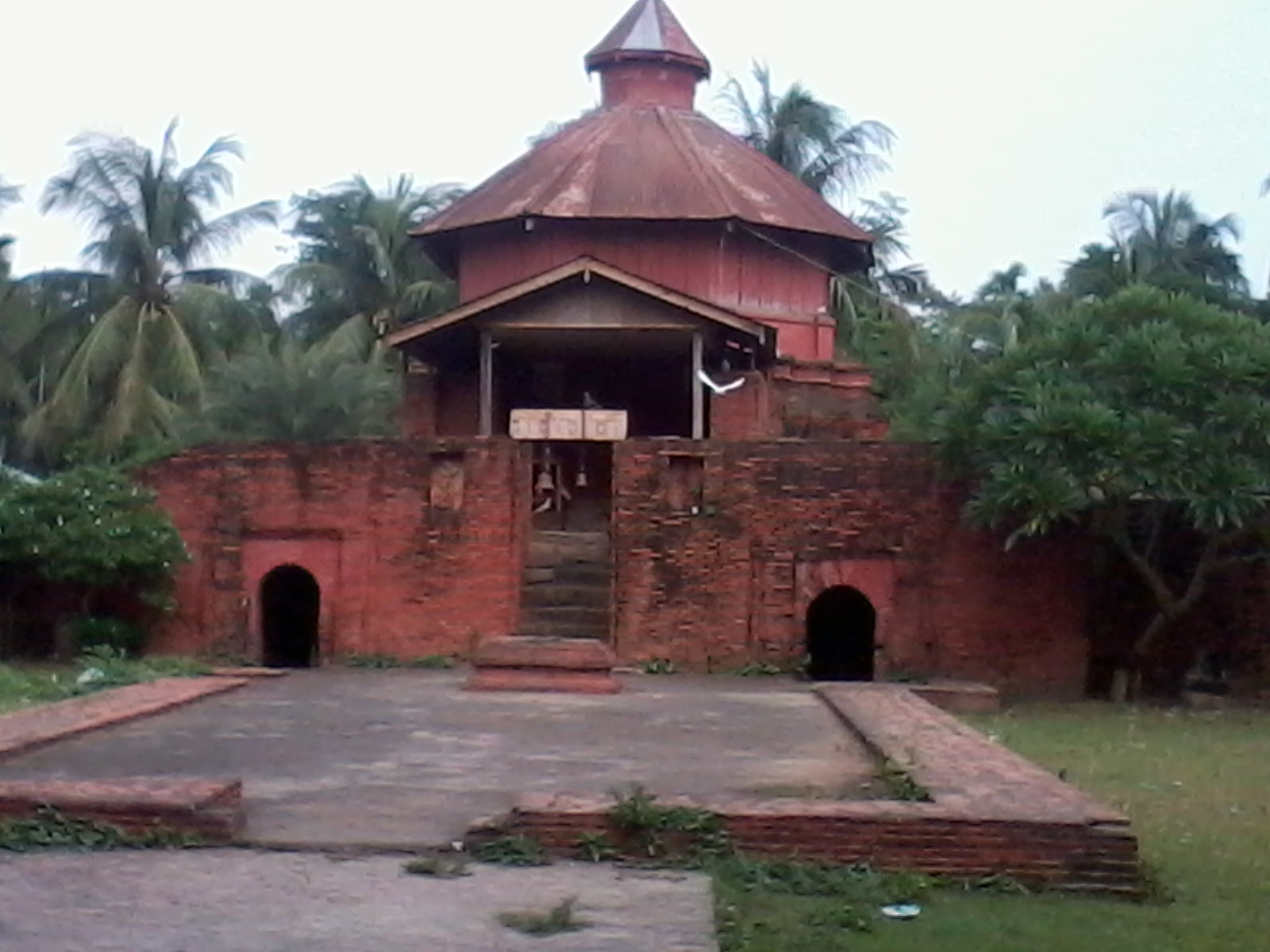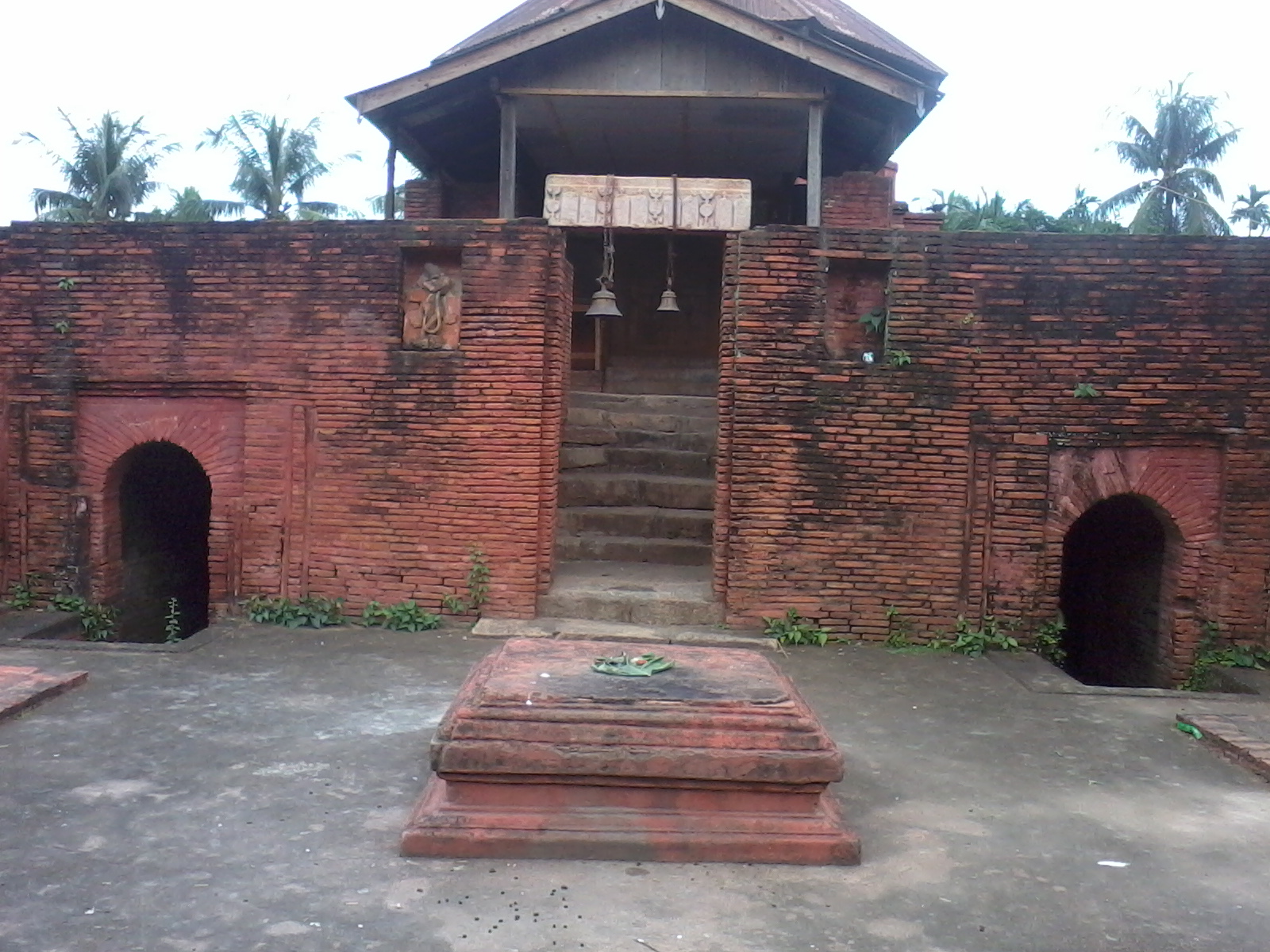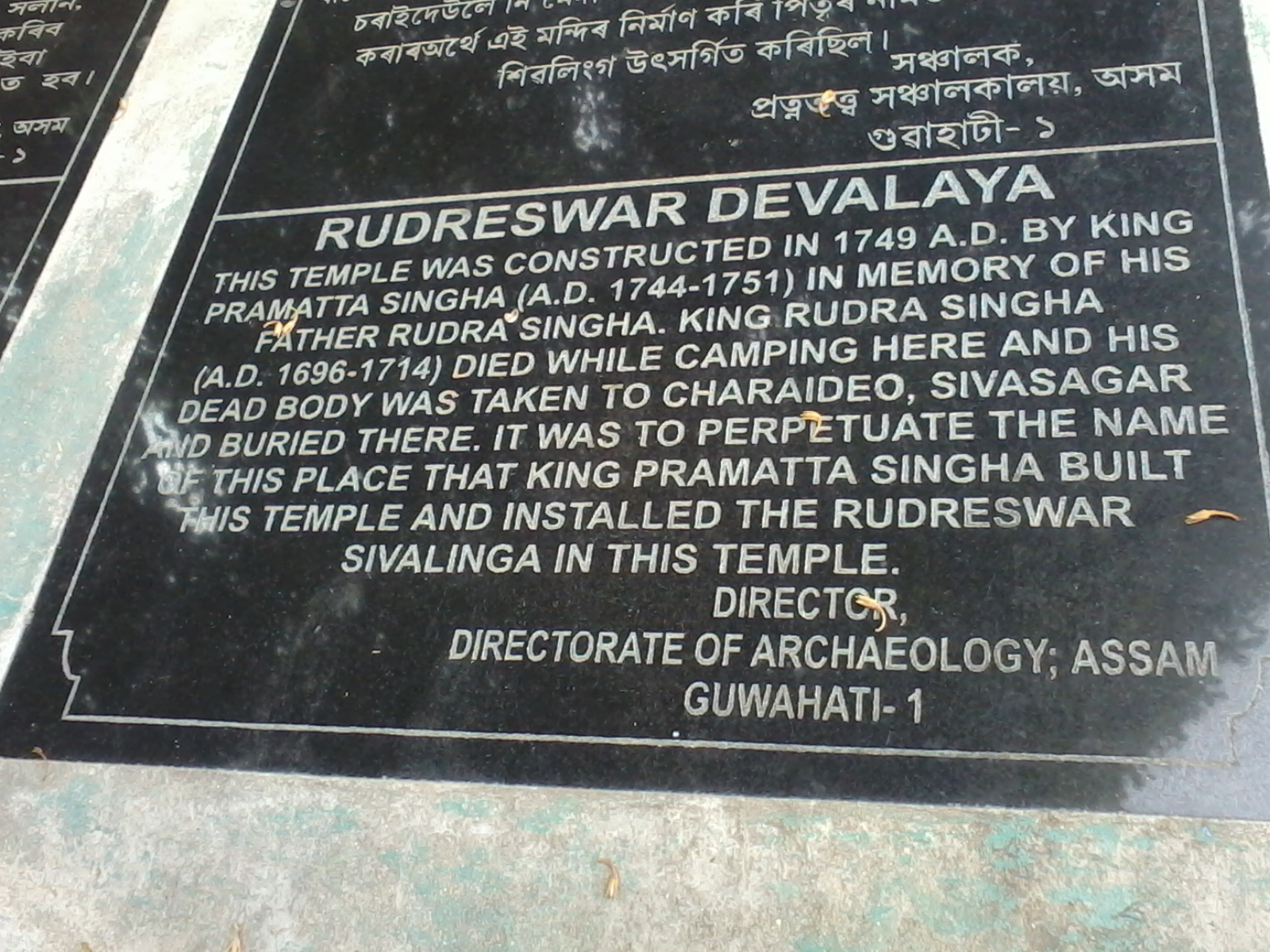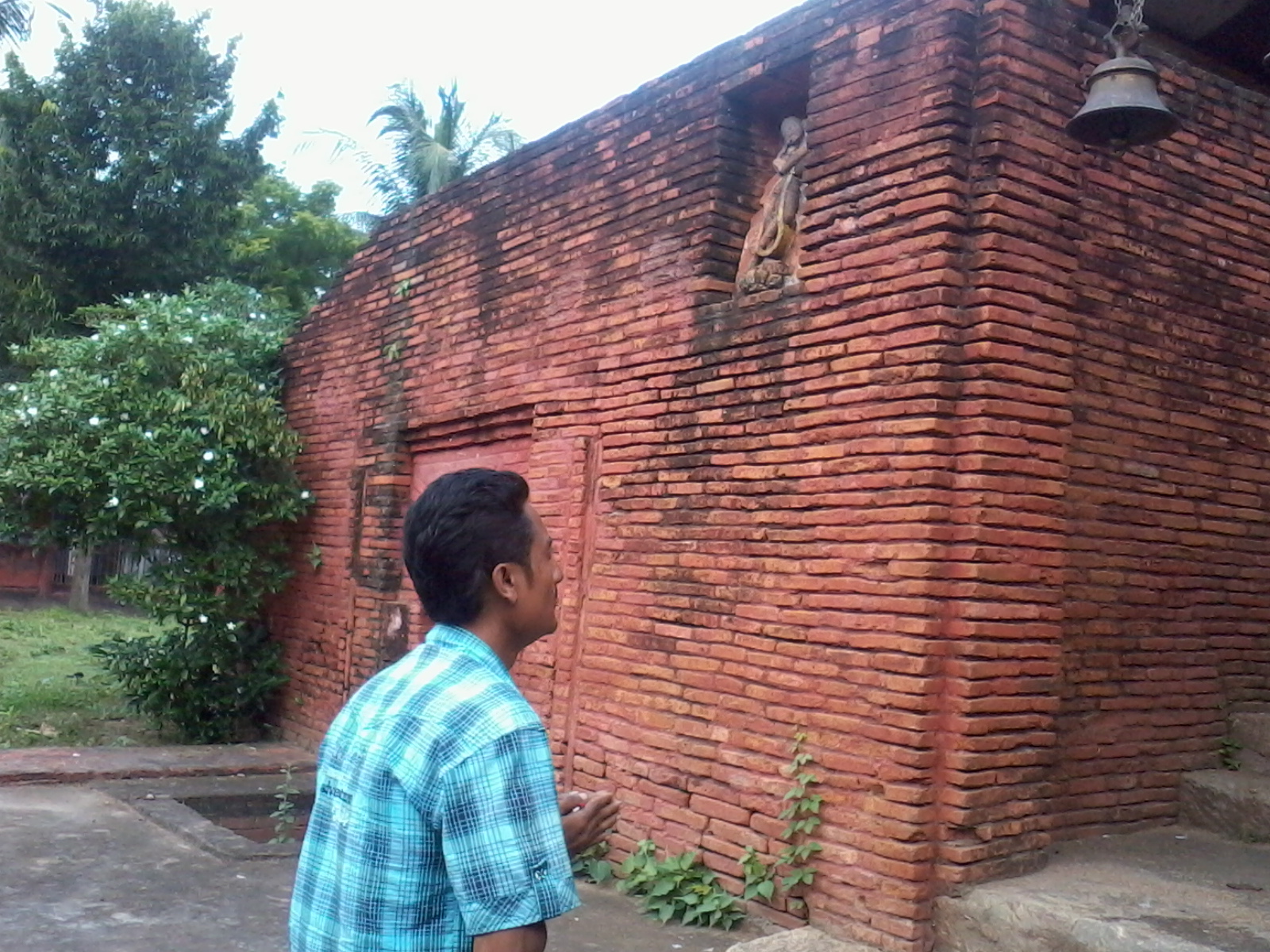Rudreswar Temple on:
[Wikipedia]
[Google]
[Amazon]
The Rudreswar Temple or Devaloya is a temple dedicated to Lord 

 It is not known precisely why these underground chambers were constructed, but, one can assume it was constructed for storing foods and other necessary items required for daily functioning of the temple. The Manikut (literally the jewel hut) or the chamber where the Shiva linga was present, is constructed above the underground chambers. Drainage system along with air ventilation system can also be seen in the structure of the temple. The temple was surrounded by a brick wall from all sides. The wall had two stone inscriptions of Ahom period which are presently preserved in museum.
There is pond near the temple which is known as Konwari pukhuri or pond for the princess (Konwari in Assamese language refers to princess or queens of the kings). According to local people, the pond was used for bathing by the queens and princesses of Ahom king
It is not known precisely why these underground chambers were constructed, but, one can assume it was constructed for storing foods and other necessary items required for daily functioning of the temple. The Manikut (literally the jewel hut) or the chamber where the Shiva linga was present, is constructed above the underground chambers. Drainage system along with air ventilation system can also be seen in the structure of the temple. The temple was surrounded by a brick wall from all sides. The wall had two stone inscriptions of Ahom period which are presently preserved in museum.
There is pond near the temple which is known as Konwari pukhuri or pond for the princess (Konwari in Assamese language refers to princess or queens of the kings). According to local people, the pond was used for bathing by the queens and princesses of Ahom king  Towards east from Konwari Pukhuri, another pair of ponds existed known as Hiloidari Pukhuri or the ponds of the artillery-men and musketeers(Hiloidari in Assamese language means musketeers or soldiers engaged in artillery).
Towards east from Konwari Pukhuri, another pair of ponds existed known as Hiloidari Pukhuri or the ponds of the artillery-men and musketeers(Hiloidari in Assamese language means musketeers or soldiers engaged in artillery).

 {{Hindu Temples in Assam
Hindu temples in Guwahati
{{Hindu Temples in Assam
Hindu temples in Guwahati
Shiva
Shiva (; sa, शिव, lit=The Auspicious One, Śiva ), also known as Mahadeva (; ɐɦaːd̪eːʋɐ, or Hara, is one of the principal deities of Hinduism. He is the Supreme Being in Shaivism, one of the major traditions within Hindu ...
in the village of Rudreswar, under Sila Sindhurighopa Mouza (revenue circle), on northern bank of the river Brahmaputra
The Brahmaputra is a trans-boundary river which flows through Tibet, northeast India, and Bangladesh. It is also known as the Yarlung Tsangpo in Tibetan, the Siang/Dihang River in Arunachali, Luit in Assamese, and Jamuna River in Bangla. It ...
, in Guwahati
Guwahati (, ; formerly rendered Gauhati, ) is the biggest city of the Indian state of Assam and also the largest metropolis in northeastern India. Dispur, the capital of Assam, is in the circuit city region located within Guwahati and is the ...
. Built in 1749 CE by Ahom king Pramatta Singha
Sunenphaa () also, Pramatta Singha, was the king of Ahom Kingdom. He succeeded his elder brother Swargadeo Siva Singha, as the king of Ahom Kingdom. His reign of seven years was peaceful and prosperous. He constructed numerous buildings and t ...
, in memory of his father Swargadeo Rudra Singha
Sukhrungphaa (reigned 1696–1714), or Swargadeo Rudra Singha, was a Tungkhungia ahom king and 30th king of the Ahom kingdom under whom the kingdom reached its zenith of power and glory, he is considered as the most illustrious of the Ah ...
, the temple is a fine example of a mixed style of Ahom-Mughal architecture.


History
In the latter part of his reign, Swargadeo Rudra Singha announced his desire to expandAssam
Assam (; ) is a state in northeastern India, south of the eastern Himalayas along the Brahmaputra and Barak River valleys. Assam covers an area of . The state is bordered by Bhutan and Arunachal Pradesh to the north; Nagaland and Manipur ...
westward as far as the river Karatoya in present-day West Bengal
West Bengal (, Bengali: ''Poshchim Bongo'', , abbr. WB) is a state in the eastern portion of India. It is situated along the Bay of Bengal, along with a population of over 91 million inhabitants within an area of . West Bengal is the fourt ...
and Bangladesh
Bangladesh (}, ), officially the People's Republic of Bangladesh, is a country in South Asia. It is the eighth-most populous country in the world, with a population exceeding 165 million people in an area of . Bangladesh is among the mos ...
, which was considered the frontier of the ancient Kamarupa
Kamarupa (; also called Pragjyotisha or Pragjyotisha-Kamarupa), an early state during the Classical period on the Indian subcontinent, was (along with Davaka) the first historical kingdom of Assam.
Though Kamarupa prevailed from 350 to 11 ...
kingdom. Some sources also indicate that his ambition was to include a portion of the sacred Ganga
The Ganges ( ) (in India: Ganga ( ); in Bangladesh: Padma ( )). "The Ganges Basin, known in India as the Ganga and in Bangladesh as the Padma, is an international river to which India, Bangladesh, Nepal and China are the riparian states." is ...
river within his domain. Since Bengal
Bengal ( ; bn, বাংলা/বঙ্গ, translit=Bānglā/Bôngô, ) is a geopolitical, cultural and historical region in South Asia, specifically in the eastern part of the Indian subcontinent at the apex of the Bay of Bengal, predom ...
was under the rule of the Mughals
The Mughal Empire was an early-modern empire that controlled much of South Asia between the 16th and 19th centuries. Quote: "Although the first two Timurid emperors and many of their noblemen were recent migrants to the subcontinent, the d ...
, he began to prepare for a massive military expedition against the Mughal Empire. An army of approximately 400,000 soldiers gathered in Guwahati
Guwahati (, ; formerly rendered Gauhati, ) is the biggest city of the Indian state of Assam and also the largest metropolis in northeastern India. Dispur, the capital of Assam, is in the circuit city region located within Guwahati and is the ...
, in which various tribes from the hills and plains came together, including the king of Cachar
Cachar district is an administrative district in the state of Assam in India. After independence the undivided Cachar district was split into four districts in Assam: Dima Hasao district (formerly North Cachar Hills), Cachar district alongside ...
and the king of Jaintia from present day Meghalaya
Meghalaya (, or , meaning "abode of clouds"; from Sanskrit , "cloud" + , "abode") is a states and union territories of India, state in northeastern India. Meghalaya was formed on 21 January 1972 by carving out two districts from the state of As ...
. His efforts were in vain. Before his preparations were completed he was seized with a mortal illness and died in August 1714 in his camp at Guwahati. His body was taken to Charaideo
Charaideo or Che-Rai-Doi (Literally: ''the shining city on the hills'' in Ahom language) is a town in Charaideo district, Assam, India and was also the first capital of the Ahom kingdom established by the first Ahom king Chao Lung Siu-Ka-Pha ...
, in present-day Sivasagar District
Sivasagar district (Pron: or ), formerly known as ''Sibsagar'', is one of the 34 districts of Assam state in Northeast India. Sivasagar city is the administrative headquarters of this district. This historic place is also known for its rich bi ...
, for burial as per ancient Tai-Ahom custom. According to some sources, Rudra Singha was cremated according to Hindu
Hindus (; ) are people who religiously adhere to Hinduism.Jeffery D. Long (2007), A Vision for Hinduism, IB Tauris, , pages 35–37 Historically, the term has also been used as a geographical, cultural, and later religious identifier for ...
customs in North Guwahati, while some denote only one of his small fingers was burnt in this way.Sarma Siva Mahatirtha Asom published by Utpal Hazarika on behalf of Bani Mandir first edition 2007 Guwahati pp 93-94. His second son, Pramatta Singha, after ascending to the throne, decided to construct in Guwahati a temple to Lord Shiva
Shiva (; sa, शिव, lit=The Auspicious One, Śiva ), also known as Mahadeva (; ɐɦaːd̪eːʋɐ, or Hara, is one of the principal deities of Hinduism. He is the Supreme Being in Shaivism, one of the major traditions within Hindu ...
in memory of his father. The site of his father's death was selected for the construction of the temple.Neog Dr. Maheswar Pavitra Asam or The Sacred Assam 4th edition 2008 Kiran Prakashan, Dhemaji page 264-265.
The temple was completed in 1749. After the completion of the temple, Pramatta Singha established a Shiva Linga
A lingam ( sa, लिङ्ग , lit. "sign, symbol or mark"), sometimes referred to as linga or Shiva linga, is an abstract or aniconic representation of the Hindu god Shiva in Shaivism. It is typically the primary ''murti'' or devotional im ...
in the temple and named it Rudreswar Shiva Linga, after his father Swargadeo Rudra Singha. The temple was named Rudreswar Devalaya and hence the village on which the temple was constructed is also known as Rudreswar. The king made arrangements for priests and people to maintain the temple and a donated large area of land in the name of the temple.
Design and structure
The temple was constructed using the architectural design of bothAhom Ahom may refer to:
*Ahom people, an ethnic community in Assam
* Ahom language, a language associated with the Ahom people
*Ahom religion, an ethnic folk religion of Tai-Ahom people
*Ahom alphabet, a script used to write the Ahom language
* Ahom kin ...
and Mughals
The Mughal Empire was an early-modern empire that controlled much of South Asia between the 16th and 19th centuries. Quote: "Although the first two Timurid emperors and many of their noblemen were recent migrants to the subcontinent, the d ...
. The design of the temple is an imitation of the Mughal mausoleum. The temple has underground chambers whose entrances are present at the front side of the temple.  It is not known precisely why these underground chambers were constructed, but, one can assume it was constructed for storing foods and other necessary items required for daily functioning of the temple. The Manikut (literally the jewel hut) or the chamber where the Shiva linga was present, is constructed above the underground chambers. Drainage system along with air ventilation system can also be seen in the structure of the temple. The temple was surrounded by a brick wall from all sides. The wall had two stone inscriptions of Ahom period which are presently preserved in museum.
There is pond near the temple which is known as Konwari pukhuri or pond for the princess (Konwari in Assamese language refers to princess or queens of the kings). According to local people, the pond was used for bathing by the queens and princesses of Ahom king
It is not known precisely why these underground chambers were constructed, but, one can assume it was constructed for storing foods and other necessary items required for daily functioning of the temple. The Manikut (literally the jewel hut) or the chamber where the Shiva linga was present, is constructed above the underground chambers. Drainage system along with air ventilation system can also be seen in the structure of the temple. The temple was surrounded by a brick wall from all sides. The wall had two stone inscriptions of Ahom period which are presently preserved in museum.
There is pond near the temple which is known as Konwari pukhuri or pond for the princess (Konwari in Assamese language refers to princess or queens of the kings). According to local people, the pond was used for bathing by the queens and princesses of Ahom king Rudra Singha
Sukhrungphaa (reigned 1696–1714), or Swargadeo Rudra Singha, was a Tungkhungia ahom king and 30th king of the Ahom kingdom under whom the kingdom reached its zenith of power and glory, he is considered as the most illustrious of the Ah ...
when he was camping here for the military expedition of Bengal
Bengal ( ; bn, বাংলা/বঙ্গ, translit=Bānglā/Bôngô, ) is a geopolitical, cultural and historical region in South Asia, specifically in the eastern part of the Indian subcontinent at the apex of the Bay of Bengal, predom ...
and hence the pond got its name.  Towards east from Konwari Pukhuri, another pair of ponds existed known as Hiloidari Pukhuri or the ponds of the artillery-men and musketeers(Hiloidari in Assamese language means musketeers or soldiers engaged in artillery).
Towards east from Konwari Pukhuri, another pair of ponds existed known as Hiloidari Pukhuri or the ponds of the artillery-men and musketeers(Hiloidari in Assamese language means musketeers or soldiers engaged in artillery).

Present day
After the fall of Ahom Kingdom and establishment ofBritish
British may refer to:
Peoples, culture, and language
* British people, nationals or natives of the United Kingdom, British Overseas Territories, and Crown Dependencies.
** Britishness, the British identity and common culture
* British English, ...
rule in Assam, the temple lost much of its lands and other privileges. It suffered greatly in the 1897 Assam and 1950 Assam–Tibet earthquake
The 1950 Assam–Tibet earthquake, also known as the Assam earthquake, occurred on 15 August and had a moment magnitude of 8.6. The epicentre was located in the Mishmi Hills in India, known in Chinese as the Qilinggong Mountains (), south of the ...
s. The temple's upper structure suffered tremendous damages. The local people, in a bid to preserve the temple, constructed the Manikut or the chamber where main religious function is held, roughly by woods and tins, to continue their religious functions. Later the temple came under the preservation of Archaeological Society of India (ASI) and the Government of Assam
Assam (; ) is a state in northeastern India, south of the eastern Himalayas along the Brahmaputra and Barak River valleys. Assam covers an area of . The state is bordered by Bhutan and Arunachal Pradesh to the north; Nagaland and Manipur ...
is also taking several steps for the restoration of the temple but still the construction is not yet complete.
References
 {{Hindu Temples in Assam
Hindu temples in Guwahati
{{Hindu Temples in Assam
Hindu temples in Guwahati